Introduction
Company analysis plays a vital role in developing a basic understanding of the company, its management, financial, marketing, and inventory control system of the organization. This report has mainly concerned with examining the capabilities of an individual entity to understand any company’s distribution, transport, and inventory system. To address these issues, here the selected organization would be a distribution/ 3PL company, and considering this criterion, LG Electronics is a perfect choice to make this report in a proper manner. LG is a multinational concern dealing its business with the latest plasma television, LCD monitors, cell phones, kitchen appliances, computer products, refrigerators, TV, audio, video systems, and many more.
Background information
Business
LG Electronics is continuing its manufacturing, information, and communicating products in 77 different countries all over the world. The company is breaking down its business into different units, which are Digital appliances, Digital display, Digital media, and finally mobile communications. LG Electronics is operating its business under LG Group, which has a significant and globally recognized brand worldwide from the Asia Pacific to Western Europe. The productions of LG Electronics are concentrated in low-cost areas, like Southeast Asia and China. The manufacturing of kitchen appliances is established in South Korea, the Philippines, Vietnam, Thailand, China, and India, which are bulk production sites of the business (Euromonitor, 2008).
Type of products
LG Electronics are always committed to innovation, communication, engagement, and entertainment with the latest technology. From the very beginning, the company has been incorporating innovative technology, like award winning LCD and Plasma displays with various ranges and superior services in the market. It has always proven itself as complete solutions provider to its customers with unique and distinct products, which are: (lge.com, 2010)
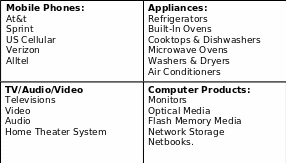
Major customers
As a leading electronics product manufacturer in the world, LGE has some corporate level customers along with individual customers. In these two broad categories, there can be some categorization, which will be helpful to assess the customer needs and expectations. In addition, different types of customers have different level of demands, for example, the hotels and motels mainly need television, air conditioner, and refrigerator while the healthcare centers need monitors of sophisticated natures. For these ambiguity, LG has been differentiated its customers in four categories and these are:
- Enterprises
- Channels
- Hospitality
- Healthcare
The services of LG have been dictated by these customers’ segmentations also. As LG has close concern on its stakeholders, the customers have also in secure concentration of all operation. (lge.com, 2010)
Number of employees
LG has dedicated itself for the betterment of the humankind beside its business and thus it has appointed huge human resources to ensure the better use of technologies and an enhanced environment. The numbers of employees are increasing in almost every year. In Korea, the actual numbers of employees are 28,659 and in abroad it is 55,786, which figured the total numbers of employees in almost 84,445. LG has expenses of about 1830.9 Billion KRW in 2008 as the wages and benefits of employees.
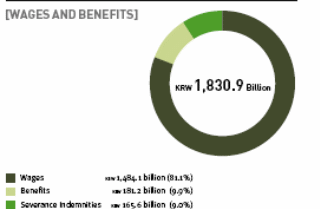
However, LG has engaged all of its stakeholders in its operators; the key responsibilities have been acted by its employees. The employees of LG have some key responsibilities like acting as a representative, communicators, to deliverer the key opinions and the main surveyor LG Electronics. (2008). (lge.com, 2010) (LG annual report 2008, 2010) (LG Electronics sustainability reports, 2008)
Management style
The management of LG has based on Holding Company system since 2003. The basic goal was to ensure the transparency and thus enable to put an end to cross-shareholding among associates. The company is now fully responsible for the investment, through this way increases the corporate value, and develops all of its operations. Under the vice-chairman and CEO, the new era of Professional management system was launched. Altogether, LG has now a framework for strengthening its business competitiveness. As a result, the total value of both corporate and shareholder has been increased.
It is noteworthy that 31% of the total share of the company is now retained by the shareholders as the numbers of share issued by the company raised up to 161,833,806. The board of directors is acting independently from the shareholders, to assist the board there are some committees like audit committee, candidate recommendation committee, management committee and so on (LG Electronics sustainability reports, 2008; pg-22).
Organizational structure
The LG has been following a flat structure of management as the hierarchy is lessened in recent times. The head of the organization is Chief Executive Officer (CEO) and under his, there are three categories of directors. There is one president, 7 vice-presidents and 14 executive vice presidents and a single CEO. The organizational chart is showing the overall picture of the organizational structures.

From the above figure, it is clear that, the subordinates of the CEO have been divided in to three categories: Staff, Company, and Region. This categorization has been done by the nature of tasks of staffs, like financial, human resource, technology, marketing and many more. The company activities are also thus divided in five companies and the regional divide is based on the geographic segmentation (LG Electronics, 2008).
Financial position
From the non-consolidated balance sheet of the year 2008, it is found that the total assets of LGE (LG Electronics) were 17337881 million Korean won (Korean Currency). Beside, the total liabilities were 8931076 million. Both the assets and liabilities had been increased in 2008 from 2007. Thus, it can be argued that the company has most assets than liability. The current ratio is 0.76, which means it has a good liquidity. (LG annual report, 2008; pg-42)
The total operating profit of parent company was 1226.9 billion KRW (Currency of South Korean) while the consolidated profit was 2133 billion. The sales in domestic market were almost 6445.2 and exports were 21193.3 billion (LG Electronics, 2008).
Number and types of facilities
LG has a global production network based on economic benefits. It has facilities of production about 29 in number in almost 13 countries. From these facilities, the products are made and delivered to the customers of many other countries (LG annual report 2008).
Supply chain structure of the major customer of LG- IBM
Supply chain structure is associated with decision-making processes of any organization in both long and short-term period. Strategic decisions and corporate policies are helpful in designing supply chain structure with long-term analysis and daily activities of an organization. To maintain and manage effective supply chain structure, some factors must be considered to accomplish, which are market demands, customer services, transportations, and pricing (Chopra & Meindl 2008). For these reasons, LG Electronics has realized these factors and prepared supply chain structure according to these factors, like demand, service requirements, distances, costs and other related factors.
Identify one major customer
LG has several customers in its four distinctive business users. The hospitality organization, healthcare firms, different business channels, and the enterprises all are the major corporate customers of LG. in addition; different multinational firms are the key customers of LG for many years. For this report, the international software manufacturing company “IBM” has been selected as a vital customer of LG.
The rising of global integration has brought open opportunities for incorporating and innovative IT industry in global economy. According to the annual report 2009 of IBM, the historic investments in fundamental business infrastructures were being less importance to growing nations for accessing global skills and markets. For this reason, new computing architecture was taking into new form according to standard instrumentation and interconnectivity. With the innovation and growth of advanced technologies, IBM (International Business Machine Corporation) had explored itself in business operations successfully as multinational computer technology and consulting corporation.
It has situated in Armonk, New York and United States and started its business in 19th century. From personal computers to hard disk drives, it has invented mainframe computers to nanotechnologies in its services. According to the stockholder report of IBM, it has invested in strategic way in the areas of analytics, next generation data centers, and cloud computing and green solutions. Now it has 108 strategic acquisitions, which changes its business into valuable and profitable in IT industry (IBM Corporation, 2009) and (Linkedin, 2010)
LG has resolved its business strategy by taking fundamental changes in future growth and brand strength. This new business approach is needed customer linkage in marketplace with its products. The ultimate customers or single product buyers are not only customers to focus on resources with popularity and profitability. For this reason, LG is evaluating and planning market processes with another business unit as its customer, who are already maintained holistic, efficient, and disciplined strategic marketing, which is IBM, consumer products- oriented global business services (IBM Corporation 2009).
The graph below will help to describe the supply chain structure between LG and IBM more clearly:
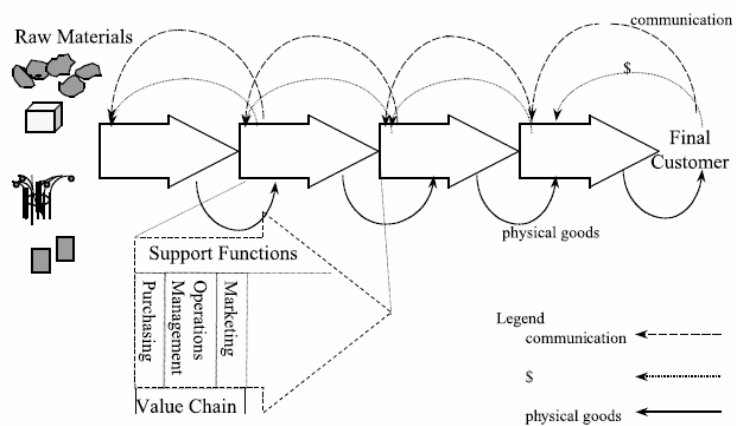
In supply chain management, LG first had to enlist IBM as corporate marketing group of major customers, which is providing further process initiatives in structure. When LG has introduced new product process with insights of the organization, then it has conducted to major customers, like IBM with strong reliance and understanding about customers’ demands on the marketplace. This process is decision-making process, which is also called stage gate methodology to identify opportunities and product development. After having the final decisions, LG is making the innovative product or developing any existing products with the help of IPD (Integrated Product Development) methodology. With the multifunctional teams of LG, the support functions, or value chain activities are performed as cross-functional tasks of supply chain structure. After these activities, LG’s business units are supplied physical goods to the IBM.
Map its distribution chain
As LG has engaged with IBM global business services to supply new and customer driven products to the market, so the distribution network has to be strong to govern the supply chain structure and development. In the figure at below demonstrates the framework of distribution chain of IBM and LG that has given more understanding about LG’s effort in business operations:
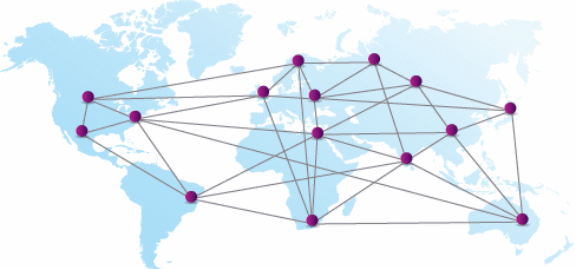
As LG is connected with IBM in distribution network all over the world, so, it can be assured that, the future growth of LG can be built on strengths of innovative products and well networking with customers, like IBM. It is more expertise in adopting innovative products, so it can realize the vision of LG more clearly (IBM Corporation 2008).
Discuss the distribution system of the identified major customer (transportation and warehousing system)
Discuss the existing system
IBM is operating in almost 170 countries of the world, which is its most significant operational aspect. It follows a strong global footprint in case of distribution. The distribution system is dedicated on the country based operating units and targeting the appropriate delivery of customer values. The distribution system followed by IBM is a source facility, which meant for the low cost facility for global production. In case of IBM, for the entire global production IBM identifies the low cost provider countries like Brazil, South Africa, and Japan. The products are being produced there and then distributed to the other countries.
In case of the distribution network design, IBM is following the Manufacturer of Distributor storage with customer pickup and in this system the products of IBM has been stored in the IBM factories and then transported to the retailers where the retailers uses warehouses the products and display fro the customers. From the cross-dock point, the products are transported to a customer pickup sites or stores from where the customers get their products.
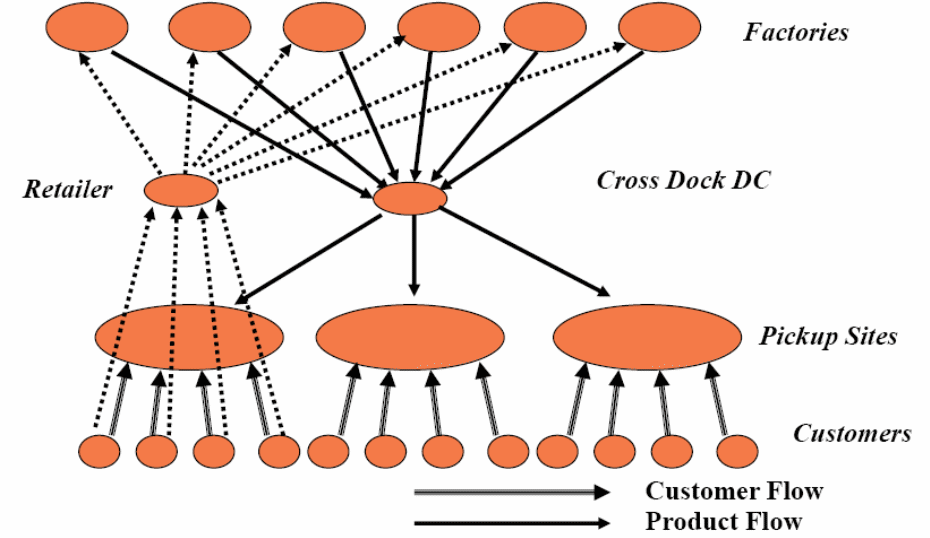
In case of the raw materials collection system of IBM, it follows an open system where it collects maximum supplies from open sources and in this way IBM collects fans used in CPUs from LG. IBM placed orders to LG and after manufacturing and testing LG provides shipment to delivery to IBM. In this case, LG is using the distributor storage with last mile delivery approach where LG supplies the materials through the distributors to the IBM’s factories directly (IBM annual report 2009).
Suggestion to improve
To improve the distribution system of IBM, it has to do certain jobs. It can introduce an integrated system of different distribution network design. Integrated system means the use of two or more distribution systems in different environment. It is now using the customer pick up techniques in case of customer as well as in case of suppliers; it is using last mile delivery. In case of customer, it can introduce the last mile delivery while the customer’s needs are being the base of the distribution system. Those customers, who have the pick up centers near to their home or residents, can go to the stores and buy the IBM products and those customers who need a home delivery can be served by using the last mile delivery. This combined technique will ensure the customer satisfaction and triggered the customer loyalty.
Secondly, In case of supplier end, IBM should prioritize the cost of transportation. When it will ask for a last mile delivery, the supplier like LG charged the extra amount for the delivery. Thus, the total cost of raw materials increased. This cost can be minimized if the retailer storage with customer pick strategy is followed by suppliers. In such a system, IBM will collect its needed raw materials from a nearer retailer of LG. Thus, it can also collect many materials from different suppliers. Further, it can compare the distance between different suppliers and select the more nearer retailers for supply.
Finally, in case of distribution and production, it can introduce the server facility where the most production will be located in a server location from where the products will be distributed to the nearer locations. In this system, there will be many servers, which will be based on assessment mainly. If IBM can introduce all these systems at once, it will gain the ultimate customer satisfaction along with differentiation in supplier selection and distribution. (Chopra & Meindl 2008)
Discuss inventory management system involved
Current policy
LG has its current policy of inventory management targeting the overall product development along with the attainment of customer satisfaction. For this, the ultimate policy is to ensure the product safety, which will further serve the customers and environmental safety. It has continuous efforts to process management and quality management through which the inventory management will be meaningful.
The development of safest product has come from three angels. These are design defects, production defects, and warning labels. The safe products development process includes:
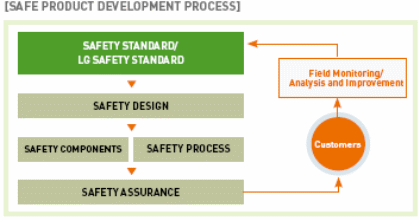
The total system comes from the need of the customers to be felt safe as well. The safety assurance comes with the combined effects of safety components and safe production process and these two is dependant on the safe design of the production. The safe design is a function of safety standards set by the LGE, which is maintained in every steps of operation. Altogether, the customers get safe products, this satisfaction of the customers is being monitored by the LG, and the information has been collected from the field and sends to the top management so that the inventory management will ensure the proper care of the product.
The other inventory management policy is to ensure the environmental friendly inventory management. Its warehouses and factories have the policy to minimize the possible lower level emission of greenhouse gas. LG has a target of reducing the GHG (Greenhouse Gas) up to 150000 tons in between 2008 to 2020. As an environment friendly inventory management tool, it is designing the GHG inventory management where there are some effective strategies for managing and reducing its GHS emission. In 2008, it became the first international verification in case of home appliances. This program of GHG reduction has been in operation in all of.
Reference
Chopra, s. & Meindl, P (2008) Supply Chain Management. 3rd ed. New Jersey: Pearson Prentice Hall.
Euromonitor (2008) LG Group: Company Factfile. Web.
Fredendall, D. L. & Hill, E. (2001) Basics of Supply Chain Management. 1st ed. CRC Press LLC.
IBM Corporation. (2008) LG Electronics designs a new product strategy that puts the customer up front. Web.
IBM Corporation. (2009) Annual report 2009 of IBM. Web.
LG Electronics. (2008) Annual report 2008 of LG. Web.
LG Electronics. (2008) LG Electronics Sustainability Report. Web.
LG Electronics. (2010). LG Commercial. Web.
LG Electronics. (2010) Product Support. [Online]. Web.
Linkedin. (2010) IBM. [Online]. Web.
Stevenson, W. J. (2005) Operations Management. 8th ed. New York: McGraw Hill.
